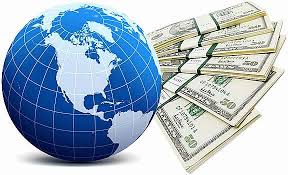KL, The Cheapest City On Earth According To WSJ
By Stan Sesser, WSJ
From my hotel window I can see one of Asia's tallest buildings -- the dramatic Petronas Twin Towers. My room is spacious and has all the little touches, such as thick terry cloth robes, that you'd expect from a five-star hotel. Downstairs, near the gym, there is a spa with hot and cold whirlpool baths. The breakfast buffet features specialties from Malaysia, China and Japan. All of this, with taxes and service charge, at the Shangri-La Hotel, is costing me US$107 a night. I haven't asked the manager for a discount, nor have I used airline miles to cover two-thirds of the cost. Rather, my room is so inexpensive because I've taken a trip to the world's cheapest major city.
Every three years, Swiss banking giant UBS does a survey of prices around the world, including what a tourist would pay for a typical overnight package of an upscale hotel room, meals, transportation and theater outings. In this year's survey, released recently, Malaysia's capital, Kuala Lumpur, took the honors, outranking cities with a reputation for budget travel such as Mumbai and Prague. Kuala Lumpur's total UBS travel package costs US$260 -- less than one-quarter of what the same package would go for in London (US$1,180) or Tokyo (US$1,090), the two most expensive cities for tourists. Of the four U.S. cities in the survey, the lowest package cost US$720 in Los Angeles and the highest was US$920 in New York.
Convergence teaches us that with globalization, emerging economies grow so rapidly that the gap narrows between them and developed countries. This might be true for the standard of living and other measures, but it often doesn't apply to tourism prices. For instance, the US$107 I paid for my Shangri-La hotel room, bought through Web site AsiaTravel.com, would have gotten me no more than the Salisbury YMCA in Hong Kong. In London, the cheapest hotel room I could find on the Internet cost US$140, and that had the bathroom down the hall. The startling price differential doesn't end at hotel rooms. Acording to the UBS survey, a three-mile taxi ride in Kuala Lumpur would be just US$1.60, compared with US$11.60 in New York and US$20.30 in London.
Just a few decades ago, Malaysia was a sleepy country living modestly off commodities such as rubber and tin. Now, the economy is booming. The country is a world-class manufacturer and exporter of everything from auto parts to computer components. Much of the explanation lies with the pro-business policies of long-time Prime Minister Mahathir Mohamad, who stepped down three years ago. He introduced tax incentives, spent lavishly on big-ticket infrastructure projects and encouraged multinational investors. Kuala Lumpur is modern and prosperous, and has numerous attractions for tourists. So, why is it so cheap? Yeah Kim Leng, chief economist of RAM Consultancy Services in Kuala Lumpur, ticks off two factors that help make it a budget destination (which also help counteract the converging tendencies of globalization).
Heading the list is an undervalued currency: The ringgit is now valued around 3.7 to the dollar compared with 2.5 when the Asian financial crisis hit in 1997, so a tourist's dollar or euro buys a lot more. Second, the government subsidizes oil prices, which lowers the overall cost of doing business and helps keep taxi fares low. Daniel Kalt, a UBS economist, attributes Kuala Lumpur's relatively consistent performance during the years between the surveys primarily to Malaysia's ability to get a firm grip on inflation. He notes that over the three-year period, Malaysia's cumulative inflation was just 5.6%, compared with 12.6% in India. Yet, for most Americans, Kuala Lumpur and the rest of Malaysia remain off the beaten path. Last year, Singapore attracted more than twice as many American tourists as did all of Malaysia, 371,000 compared with 151,000. Thailand, which borders Malaysia to the north, attracted four times as many Americans, even though Malaysia can match many of Thailand's attractions, such as stretches of uncrowded beaches backed by rain forests and mountains. Mirza Mohamed Paiyab, director general of the government's Tourism Malaysia, says the difference is primarily because Bangkok and Singapore are large air-travel hubs, the first with many connections to Indochina and the second to Bali and Australia.Of course, like any major city, Kuala Lumpur has several drawbacks for tourists. The traffic jams are mind-boggling, making a taxi ride at rush hour an exercise in frustration. Not far from the glitzy shopping malls are impoverished neighborhoods with crumbling buildings -- a reminder that not everyone is sharing in Malaysia's success.But travelers who bypass Kuala Lumpur are missing some enticing features. There's a vibrancy that matches Bangkok, with bars and restaurants crowded late into the night. Restaurants in Kuala Lumpur spill out into the streets, and sidewalk food vendors are everywhere. A mix of ethnic Chinese, Malay and Indian residents makes for a variety of excellent cuisine choices. The city has also retained large swaths of colorful ethnic neighborhoods.The Lake Gardens district offers a bird park, botanical gardens and stately colonial-era mansions. The Islamic Arts Museum is world class. The area around the landmark Petronas Towers can keep shoppers busy for days. Tourists can also take day trips to the former colonial hill station of Bukit Fraser, known as a spot for bird watching, and to the historic seaport of Melaka.And then there are the prices, the accounts of which you'll impress your neighbors with as much as your photographs. I could sample the culinary delights of Kuala Lumpur from morning to night for the cost of a main course in London. Adly Rizal, the creator of a Kuala Lumpur restaurant Web site, Friedchillies.com, notes that "eating in K.L. for only three days is like going to Disneyland in the morning and having to leave by noon."Mr. Rizal took me to an outdoor fish restaurant behind the King's Palace called Gerai Seri Malaka, where three of us ordered two whole freshwater catfish, a whole mackerel, cuttlefish, a local river fish called terubuk and big chunks of stingray, their specialty. The bill definitely won't provoke a protest from the number crunchers who see my expense account. For far more fish than we could eat, as well as accompaniments, we paid US$12.
----------------------------------------------------------------------------
p/s prices are but a function of real estate primarily, besides the two factors cited (currency undervaluation and government subsidy on certain products), the following old blogs could make for interesting reading
March 10, 2006 - Why Malaysian Real Estate Is So Cheap
March 23, 2006 - Malaysia & Its Natural Resource - Summertime & The Livin' Is Easy
August 11, 2006 - UBS Study On Price & Earnings Of Cities
Should I Be Thankful?
Having gone through the UBS study on price and earnings of global cities, I am quite convinced on the validity of the assumptions, methodology and conclusions. Firstly, they weighted according to how much it would cost to buy a basket of goods in each city, the breakdown are as follow:Food/groceries 18%; Beverages/tobacco 5%; Hygiene & healthcare 7%; Clothing 6%; Household and electronic devices 7%; Home/house 18%; Heating/lighting 5%; Transportation 14%; Miscellaneous 20%. Cost of living index is calculated on the basket of goods containing 154 items (products and services) - that is then reweighted according to the Consumer price index relevant for that specific country.
As for earnings, the wages are calculated across 14 selected industries/job types and only takes data from local people and also the prevailing tax rates.The following are the rankings of PRICES using data but NOT including rentals. The study is based on 71 business cities surveyed. New York city is pegged at 100, meaning if your city is at 95, your city is technically 5% cheaper than New York, etc...
1) Oslo 121.5
2) London 110.6
3) Copenhagen 109.2
5) Tokyo 106.8
7) New York 100
11) Paris 95.6
15) Los Angeles 91.6
19) Amsterdam 87.7
24) Seoul 85.8
27) HK 82.1
30) Sydney 80.4
32) Singapore 76.6
36) Dubai 7440) Taipei 68.9
51) Jo'burg 59.754) Bangkok 55.3
57) Jakarta 51.8
60) Shanghai 50.3
62) Beijing 49.6
67) Manila 46.7
70) Mumbai 38.5
71) Kuala Lumpur 36.8
The PRICES ranking changes substantially if rents were included, and they should be, and especially in major Asia cities: London would become the costliest city with 105.5 with New York being pegged at 100 still. Other cities which moved up the rankings when rent was included were Chicago, Los Angeles, Tokyo, Sydney and HK. But Kuala Lumpur remained the cheapest place at 71st position.
So for WAGES, as long as Kuala Lumpur does not finish at 71st also, Malaysians should be pretty well off, ... right?!! Again using New York as 100:
1) Copenhagen 118.2
2) Oslo 117
3) Zurich 115
5) New York 100
6) London 89.2
8) Dublin 88.3
18) Tokyo 78
20) Sydney 74.6
32) Seoul 44.2
36) Taipei 35.5
38) Singapore 32.3
40) HK 27.4
53) Kuala Lumpur 15.7
59) Shanghai 11.5
66) Bangkok 8.267) Mumbai 7
68) Jakarta 6.3
69) Manila 6.3
Most of the Asian cities would move up by another 10 spaces roughly if we were to take net wages instead of gross. On balance, Kuala Lumpur looks great, cheapest but gets paid by a significantly higher relative quantum, mainly we don't have to worry about excessive property prices/rentals. Fuel is still subsidised as are a number of necessities - thanks to super normal revenue from our resources (oil and gas, plantations, timber, etc...). When you put PRICES and EARNINGS side by side, you get purchasing power.
Here is the more important ranking, which is Purchasing Power, based on net wages, again with New York pegged at 100 (the higher the ranking the better, effective PP):
1) Zurich 115.6
2) Geneva 112
3) Dublin 106.5
7) New York 100
9) Sydney 99
10) Auckland 98.7
15) Oslo 91.2
20) London 86.8
24) Tokyo 81.8
31) Paris 72
35) Seoul 56.2
37) Kuala Lumpur 50.9
38) Singapore 50.8
43) Hong Kong
56) Shanghai 22.9
62) Mumbai 18
65) Bangkok 14.6
67) Manila 13.5
68) Jakarta 12.2
Guess, we should be happy.... now, if we can only get our car prices to be the global average (presently the cost of buying a car in Malaysia and Singapore is about 80%-100% more expensive than the global average).
skip to main |
skip to sidebar















tips, tricks, business, news, information, services, business, SEO, internet, websites, blogs, business, news, health, facebook, twitter, automotive, online marketing, unique, funny, zodiac, sport
Blog Archive
-
▼
2006
(308)
-
▼
October
(22)
- MBF Holdings - A Goodie Or Baddie?esteoh said...no...
- SC In The Hot SeatWhat a thankless task... you get...
- World Press Freedom Index 2006Reporters Without Bo...
- Securities Commission Ruling Needs Further Explana...
- KL, The Cheapest City On Earth According To WSJBy ...
- Why So Mad At Turf Clubs??Just received confirmati...
- NextnationSounds Like Singapore's New Name For The...
- Sack The Turf Club Committee Members Please!Barely...
- IJM & RoadbuilderChairman Q said... I am not convi...
- The Next Big Thing?After Puncak, What Can We Hope ...
- Selamat Hari Raya, Puncak NiagaWatch A Master At W...
- 101 Economic Wealth1) Par Value measurement - That...
- 1945 - Isn't That A War Game?Of course I am referi...
- Jenting & Resortssopskysalat said...Well Dali,What...
- Regulated Short Selling Will Fail DismallyBursa wi...
- NagaCorp IPO In HKYou Have Been Warned, My HK Frie...
- Ramunia Againgodzilla said: It was speculated tha...
- The Departed Infernal AffairsAllow me to indulge f...
- All Time High / 6 Year HighSo WhatThe Malaysian bo...
- Why Andy Xie Resigned?By Steven Irvine Morgan Stan...
- Only In SingaporeA True Or False Quiz, Can You Get...
- Mudslingers by Anwar IbrahimAs printed in WSJThe r...
-
▼
October
(22)
Total Pageviews
233,520
No comments:
Post a Comment